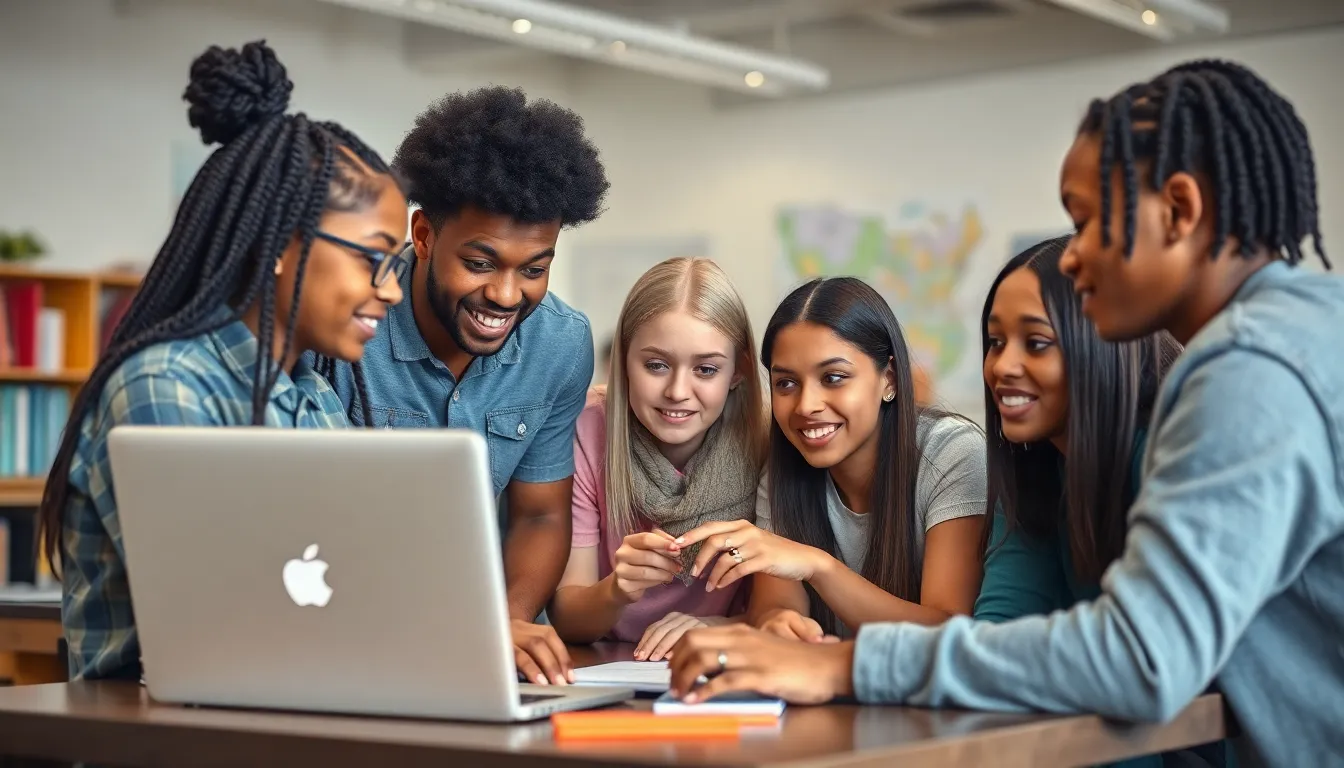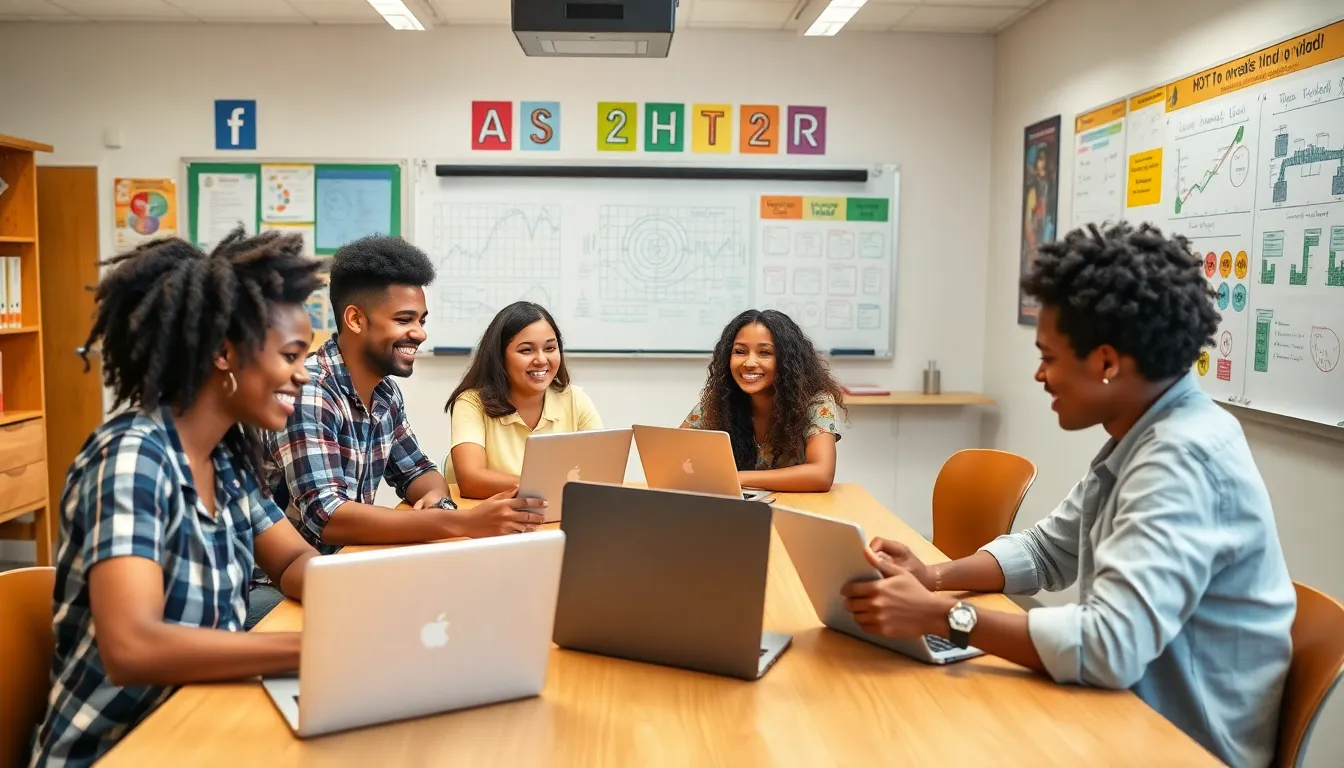In the ever-evolving world of education technology, social learning is the cool kid on the block. Imagine a classroom where students aren’t just passive listeners but active participants, sharing ideas and collaborating like they’re in a group project for the next big invention. Social learning in ed-tech harnesses the power of technology to create vibrant communities where knowledge flows freely, and learning becomes a team sport.
Table of Contents
ToggleWhat Is Social Learning in Ed-Tech?
Social learning in ed-tech refers to an approach where students learn collaboratively through interaction and engagement with peers and technology. This method encourages active participation instead of passive consumption of information. By utilizing online platforms, individuals connect in real-time, sharing knowledge and experiences that enhance understanding.
Technologies like discussion forums, social media groups, and collaborative tools facilitate this learning process. Students share insights, ask questions, and provide feedback, creating a rich learning environment. Engaging with peers not only fosters a sense of community but also develops critical thinking and communication skills.
Key elements in social learning include peer collaboration, feedback loops, and accessible resources. Peer collaboration allows students to work together on projects, enhancing their ability to solve problems collectively. Feedback loops enable learners to offer and receive constructive criticism, nurturing an iterative learning process. Accessible resources ensure that all students can engage with materials, promoting inclusivity.
Studies indicate that social learning can lead to improved retention and comprehension rates. Engaging in dialogue with peers helps solidify learning concepts, making information more memorable. Furthermore, social interaction supports diverse perspectives, enriching the overall learning experience.
Incorporating social learning strategies into ed-tech acknowledges the importance of relationships in education. This adaptive approach not only transforms the learning experience but also prepares students for collaborative work environments in their future careers. Schools and educational platforms integrating social learning principles create dynamic spaces supportive of learner success.
The Principles of Social Learning Theory

Social learning theory emphasizes learning through observation and interaction with others. This approach relies on several key concepts that shape the learning experience and highlight the significance of social engagement.
Key Concepts
Observational learning occurs when individuals learn by watching others’ behavior. Imitation plays an essential role in this process; learners replicate actions modeled by peers or instructors. Reinforcement strengthens behaviors, encouraging repetition if outcomes are favorable. Attention is critical; it influences which behaviors learners observe and internalize. Motivation drives participation in social learning environments, leading to engagement and persistence in tasks. Each of these concepts works together to foster a collaborative learning atmosphere, where ideas flourish and shared experiences enhance understanding.
Importance in Education
Social learning enhances educational experiences by creating a sense of community. Collaboration fosters deeper connections among students, promoting teamwork and problem-solving skills. Feedback loops, integral in this process, allow peers to support each other, creating a culture of continuous improvement. Accessibility to diverse perspectives enriches discussions and broadens understanding of complex topics. Research shows that social interactions in learning environments lead to higher retention rates as learners internalize information through active dialogue. These elements combine to prepare students for collaborative roles in their future careers, making social learning a vital component of modern education technology.
Tools and Platforms for Social Learning
Various tools and platforms enhance social learning in education technology. They facilitate collaboration and engagement among students.
Collaborative Learning Environments
Collaborative learning environments encourage students to interact and share ideas. Platforms like Google Workspace and Microsoft Teams allow real-time collaboration, making teamwork seamless. Engaging with peers leads to increased motivation and accountability. Online discussion boards and forums, such as Padlet or Edmodo, promote open dialogue, helping students articulate concepts clearly. Many institutions leverage tools like Miro and Trello for project management, enhancing group organization. Research shows that these collaborative methods boost retention rates by fostering deeper understanding through shared knowledge.
Social Media in Education
Social media serves as a valuable platform for educational interaction. Sites like Twitter and Facebook enable students to connect outside the classroom, forming a community around shared interests. Educators utilize these platforms to share resources and provide timely feedback. Hashtags specific to educational topics create virtual conferences, allowing wider collaboration and idea exchange. Furthermore, platforms like Instagram can showcase student projects, promoting creativity and engagement. Studies indicate that social media usage in educational contexts enhances peer learning and increases overall student satisfaction.
Benefits of Social Learning in Ed-Tech
Social learning in education technology offers numerous advantages, fostering an interactive and connected learning environment. Engaging with peers encourages collaborative experiences that enrich the educational process.
Enhanced Engagement
Active participation characterizes social learning environments. Students communicate with each other through discussions and shared projects, increasing motivation and enthusiasm. Real-time interactions allow individuals to contribute ideas, leading to a sense of ownership in their learning journey. Furthermore, utilizing tools like online discussion boards and collaboration platforms keeps students involved and responsive. The engaging atmosphere created through these interactions fosters deeper connections with the content and a well-rounded understanding of various topics.
Improved Retention Rates
Retention rates improve significantly through social learning techniques. Participating in group discussions enables learners to internalize information effectively by exchanging perspectives and clarifying concepts. Active dialogue promotes critical thinking and facilitates memory reinforcement. Research supports this claim, indicating that students engaged in collaborative learning environments demonstrate higher retention rates compared to those in traditional, isolated settings. Engaging with peers encourages learners to recall information, making it easier to apply what they’ve learned in practical situations.
Challenges and Considerations
Implementing social learning in ed-tech presents several challenges that educational institutions need to address. Technical issues can arise, including connectivity problems and platform compatibility, which hinder real-time collaboration. Inconsistent access to technology among students can create inequities, as some may lack devices or reliable internet connections.
Facilitating effective peer interaction requires thoughtful organization. Educators must structure activities that encourage participation while managing diverse group dynamics. Large groups can complicate discussions, leading to disengagement for some students.
Privacy and safety considerations also play a vital role in social learning environments. Protecting students’ personal information on online platforms is essential. Educators must ensure that communication remains respectful and constructive, reinforcing positive interactions.
Motivation may also vary among learners. While some engage enthusiastically, others may feel intimidated or hesitant to participate. Developing strategies that foster inclusivity and build confidence within social learning frameworks is key.
Evaluating the effectiveness of social learning initiatives poses another challenge. Institutions need clear metrics to assess engagement and learning outcomes. Gathering consistent feedback and adapting programs enhances overall effectiveness.
Balancing structure and flexibility in social learning is crucial for success. Too much structure can stifle creativity, while excessive freedom can lead to chaos. Finding a middle ground fosters an environment where collaboration flourishes.
Ultimately, addressing these challenges requires ongoing commitment from educators and institutions. Supporting students through intentional design and continuous feedback strengthens social learning experiences, maximizing their benefits.
Social learning in ed-tech represents a significant shift in how students engage with their education. By leveraging technology to foster collaboration and interaction, educational institutions can create vibrant learning communities that enhance understanding and retention. This approach not only prepares students for future careers but also cultivates essential skills like teamwork and critical thinking.
While challenges exist, the benefits of social learning far outweigh the obstacles. With ongoing commitment and thoughtful implementation, educators can harness the power of social learning to enrich the educational experience. Embracing this innovative approach will ultimately lead to a more engaging and effective learning environment for all students.




